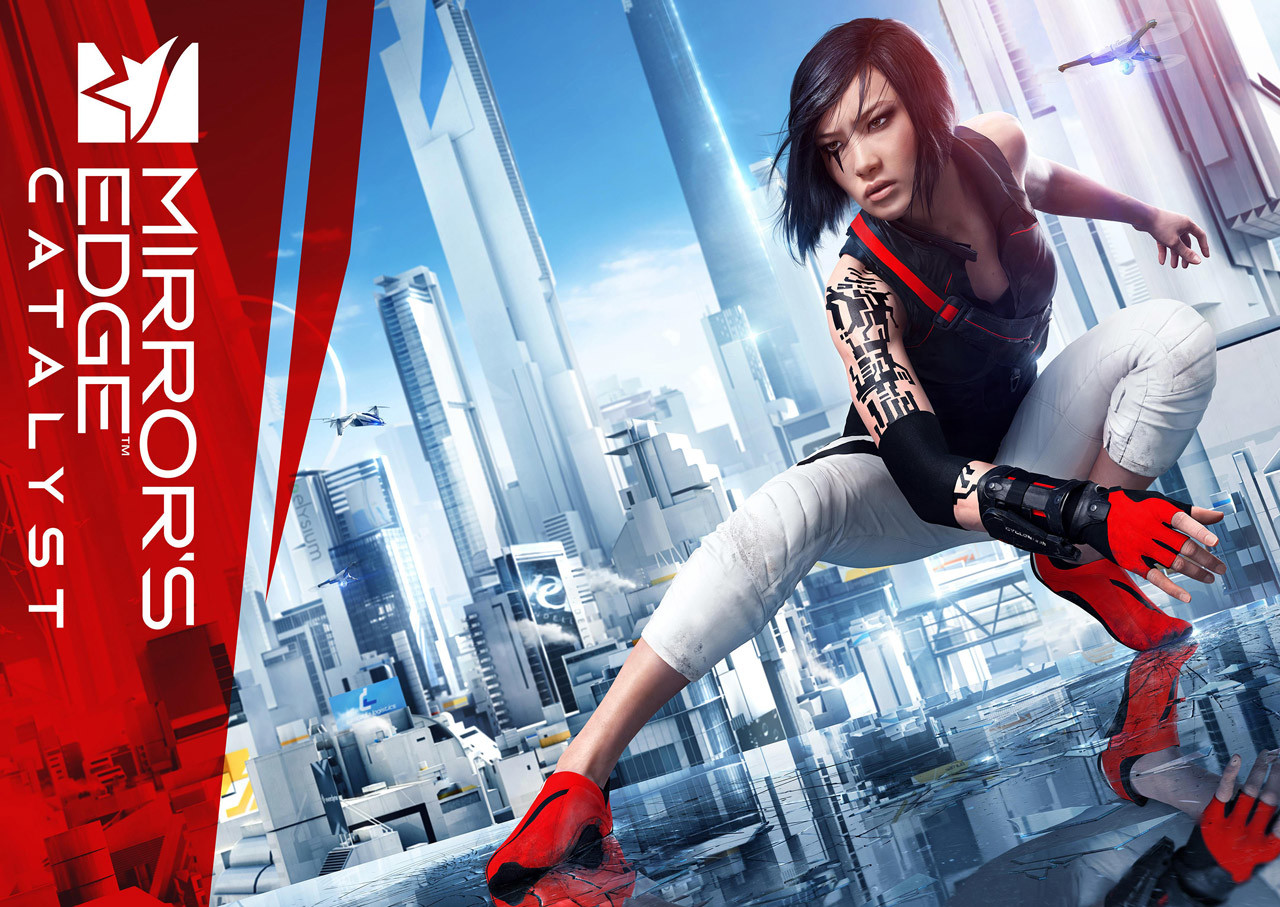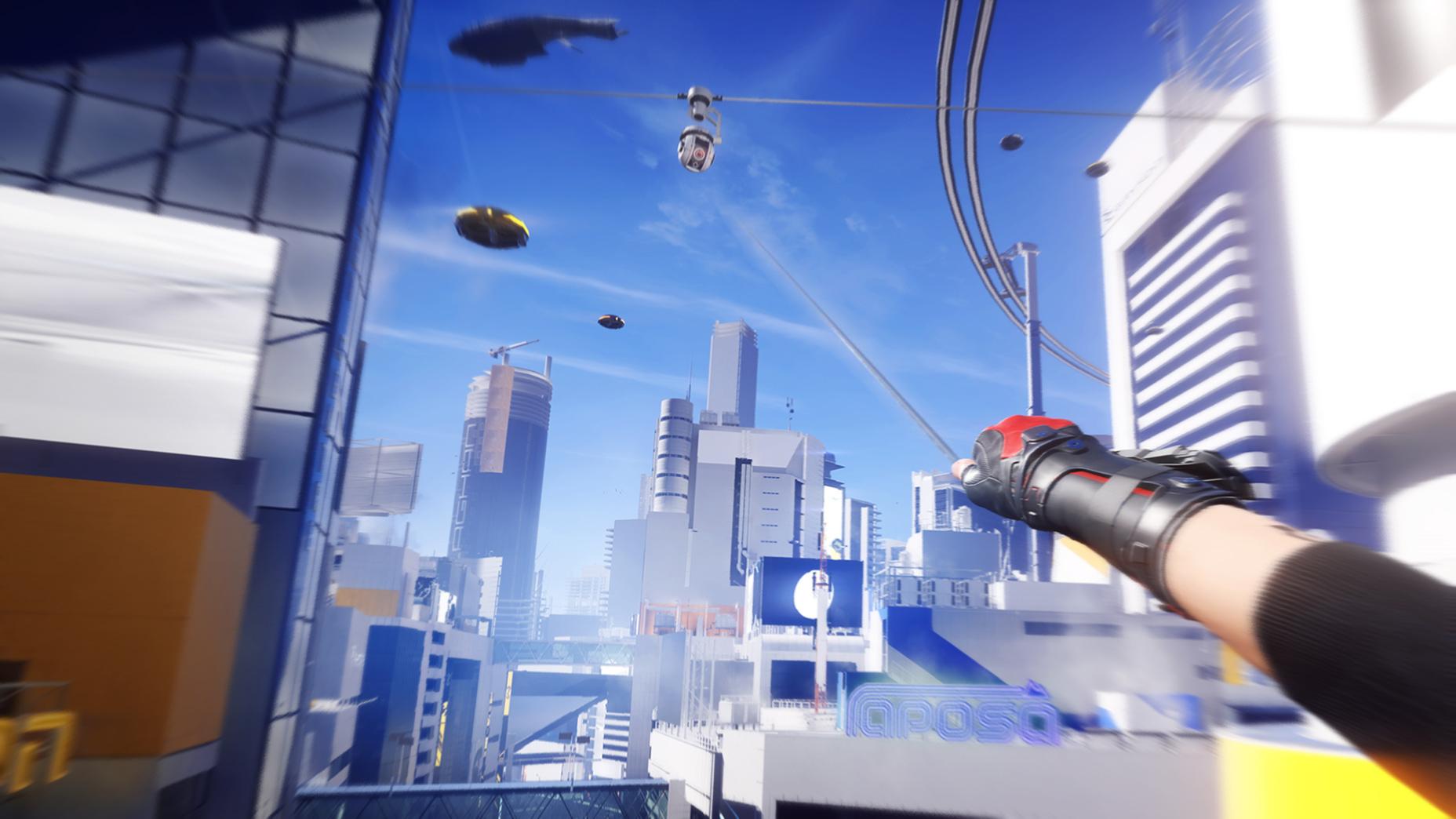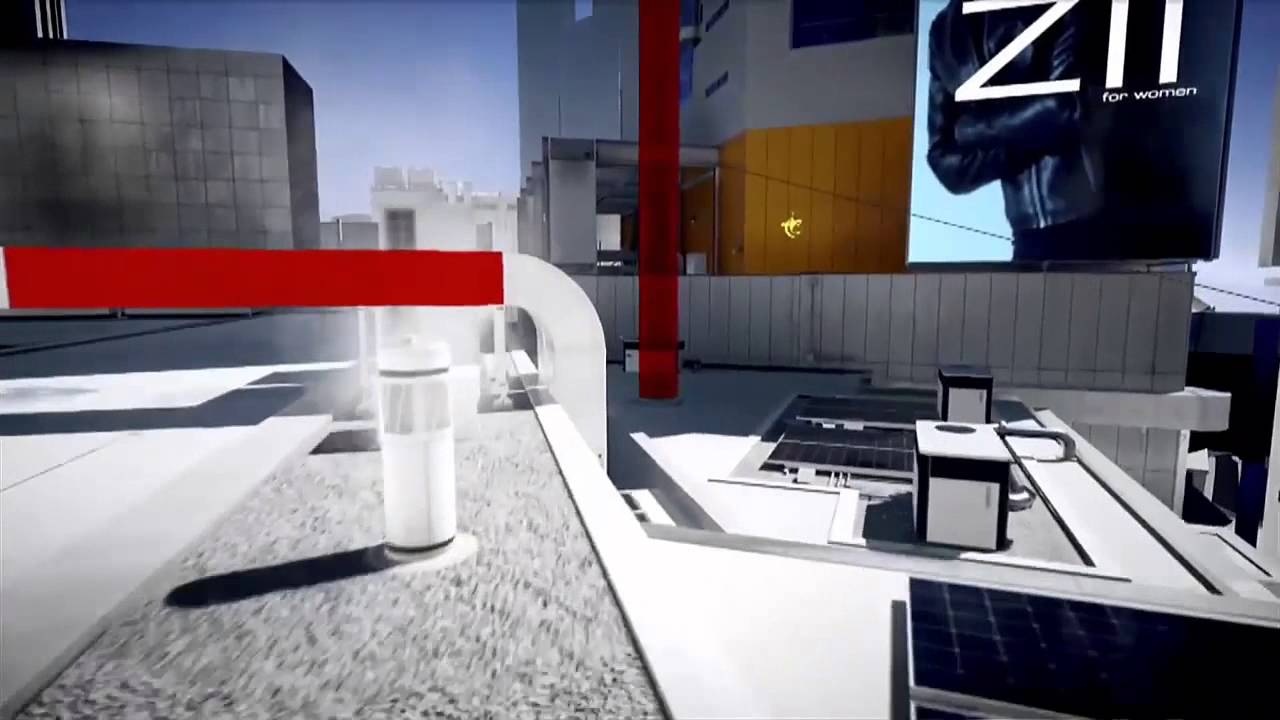MIRROR’S EDGE: CATALYST Review

In the city of Glass, a towering, sterile dystopia under the authoritarian rule of a dictatorial corporation, runners traverse through the expansive rooftops and play tag with the police. That’s at least all you really need to know to be acquainted with MIRROR’S EDGE: CATALYST, EA DICE’s attempt to bring back the 2008 fan favorite, MIRROR’S EDGE. In doing so they’ve changed up the structure a little but still maintained the core gameplay, making for a reboot that plays more like a TONY HAWK’S UNDERGROUND rather than a PRO SKATER 2, both to and against its advantage.
Here’s the thing, though: EA’s 2008 outing was not a particularly good game in my opinion. MIRROR’S EDGE did a lot to advertise itself as a momentous free-running adventure, but save for its first handful of levels, MIRROR’S EDGE was a fairly railroaded game with a clumsy fighting system, shoddy gunplay, and a bevy of stages that failed to take advantage of the running mechanic. And yet, its unique design and satisfying parkour gameplay made for quite the fanbase. But if there’s one thing I can’t forgive a game for, it’s being deceitful, and MIRROR’S EDGE felt like it was laughing at my face when I realized that I was just playing a glorified on-foot racing game rather than a true free-running experience.
MIRROR’S EDGE: CATALYST surely heard a lot of my cries, and in an attempt to fix them, created new potholes of its own. First and foremost, this 2016 vehicle is an open world journey, boasting an aesthetically gorgeous map and strong level design that allows for the map to never really get old despite how often you’ve travelled through it. Furthermore, the fact that your trips are no longer as restrictive as the previous installment really lets EA DICE put the “free” in “free running.” The linear maps of old have been replaced with intricate mazes, and travelling backwards after completing a time trial is oftentimes a fascinating way to realize just how complex the design can get, because developers now have to account for the fact that going from A to B also means that there needs to be a path from B to A.
As such, running without setting a waypoint for yourself is honestly the most fun I’ve had playing MIRROR’S EDGE: CATALYST. Finding my own way around Glass and just picking up a quest if I happen upon it feels a lot more satisfying than having the game constantly tell me where to go. When being chased by cops, escaping police choppers feels rewarding exactly because you don’t have to follow any preordained path. Because gunplay has also been removed entirely and hand-to-hand combat really only exists in order to kick enemies out of the way in order to keep running, MIRROR’S EDGE: CATALYST is at its best when you aren’t being railroaded, freely traversing the map and maybe picking up a Gridlink or two along the way.

Leaps of Faith… Shoot me
The main quest is filled with gorgeous set pieces and often breathtaking level design. The newly incorporated grappling hook honestly does Spider-Man better than any Spider-Man game ever did, and the rush of completing these levels without a hitch is a huge adrenaline kick in its own right. Unfortunately, the dialogue is abysmal and each character is an absolute joke. Faith is moody and lacks empathy and other characters are mostly cardboard cutouts masquerading as real people. It’s honestly a shame considering that it’s a female-centric cast featuring lots of people of color, but I’m ready to let this slide considering that I don’t play Tony Hawk games for their story either.
MIRROR’S EDGE’s color-coded universe is still present. Unfortunately, the toll that the open world takes on the level design is that now color coding can no longer subconsciously guide the player in the right direction, because the developers don’t always know where you want to be going. Consequently, tinted items are often walls or items that you can parkour over, but the game’s signature runner’s vision has now been downgraded to an incredibly lazy guiding line that highlights certain objects in a bright red.
This lazy design tactic doesn’t necessarily ruin the experience as much as it misses an incredible alternative opportunity. Instead of getting a breadcrumb-feeding guiding line every time you set a waypoint, it would be have been fantastic if the whole game world would have simply been colored white and grey, but certain assets can turn orange or blue when a waypoint is set in order to assist you. Through shifting wall-colors, the world would also come to life in a way that it doesn’t right now, and players would be treated to a slightly more inventive mechanic as a result.
The problem here isn’t so much that the game doesn’t play well — in fact, it still is incredibly satisfying when you are really nailing a run — but the excessive use of glowing reds make for an experience that feels like an endless tutorial. Thanks to an extremely customizable options tab, Runner’s Vision can be turned off completely, and even Field of View can be adjusted, but unfortunately any time trial side quest is virtually impossible without Runner’s Vision.

Green is not a creative color
CATALYST’s opening does a great job at immediately giving you power while allowing you to learn the controls, all in the midst of a clever, contextualized sequence in which your protagonist, Faith, has just been released from prison and is already going off the grid again. Her ultra-lame companion, Icarus, feels like a Zero archetype from MEGA MAN X, and boasts all of the abilities Faith has yet to acquire, demonstrating the gameplay potential to come. Yet somehow, EA DICE ruins this fantastic opening by then shoehorning a boring training arena in which controls are taught to you piecemeal like it’s 2005.
And that’s really what sucks so much about MIRROR’S EDGE: CATALYST. The game itself runs at a fluid 60fps and feels satisfyingly next-gen with its large open world and great parkour controls. But despite all of this, its core design is fundamentally dated. Every sidequest is a deviation of a time-trial, and although they’re always fun — and oftentimes extremely challenging — they’re also irresponsibly unoriginal and lazy.
The lifeless map is something I’m willing to excuse on behalf of the fact that Glass is supposed to be a sterile dystopia, but the fact that random characters are awkwardly positioned in various spots across the map because they will someday hand you a quest is so old-fashioned that I’d might as well be playing a PS2 game. Furthermore, loading times are roughly 10 seconds in length when you die or restart from a checkpoint. This is acceptable during main quests, but can feel like an eternity during the brief, minute-long time trials that you will inevitably play a half dozen times before you perfect.
The diversion side quests are ruthlessly ill-designed, forcing you to run through crowds of enemy patrols in a given amount of time. For some reason, however, the timer does not give you time when enemies spot you, except when you walk through the center of where they’re located. This abysmal design choice makes for some of the most frustrating side quests I’ve played in a while.

You can’t blame the actress for being shitty when she’s a CG render
What’s doubly frustrating is that instead of not having anything exciting to offer, MIRROR’S EDGE: CATALYST is a good game that misses great opportunities, and thus ends up feeling more like an unfinished beta rather than a complete gaming experience. The absence of any holistic level design is what really kills the world EA DICE have created. Despite being fun to traverse, I can never shake the feeling that it’s weird that Faith is the only free-runner in the entire map. The narrative makes it unequivocally clear that there are countless runners scattered across the city, so why do I never see somebody running around, being chased by the authorities?
None of this would be a problem if MIRROR’S EDGE: CATALYST would be decidedly old school, but it wants to be a next-gen experience, and fails to deliver on all fronts except its control scheme. And yet, it is hard not to recommend the game because there really isn’t anything else like it. The closest alternative to this free-running experience would be ASSASSIN’S CREED, a franchise that has steadily been moving further and further away from the parkour gameplay that made it famous. In the same way, MIRROR’S EDGE: CATALYST is a game that’s undeniably entertaining, but one that boasts so many new flaws in its attempt to deviate from the original’s formula that it’s really a matter of taste as to which game plays better. For what it’s worth, simply thanks to its open world, MIRROR’S EDGE: CATALYST is a slight improvement over its predecessor in my eyes, but not one that will win over a lot of new players.
Verdict: Do Not Recommend
Reviewed on PlayStation 4, also available on Xbox One and PC.



